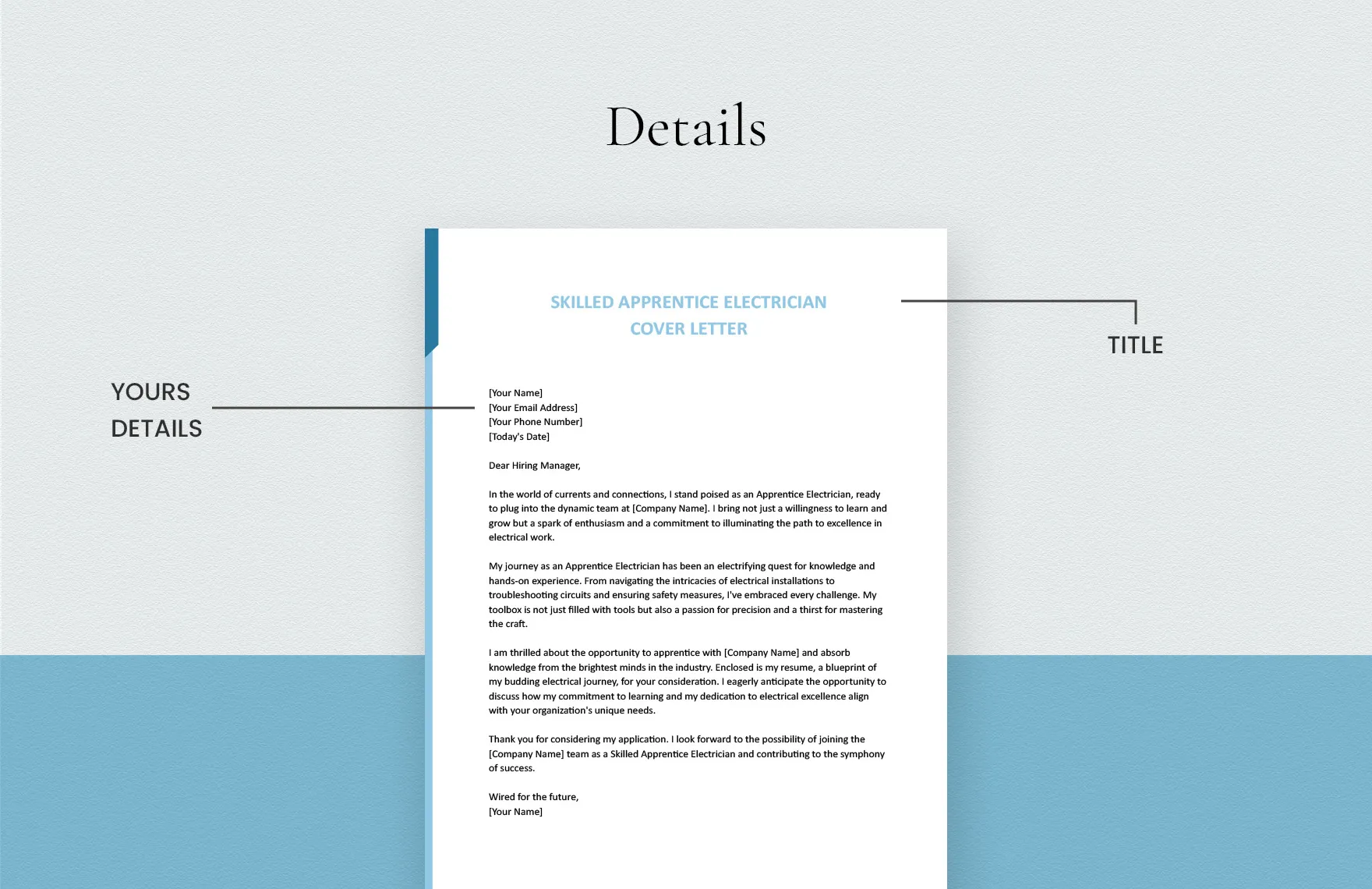Crafting Your Electrical Apprenticeship Cover Letter
Embarking on an electrical apprenticeship is an excellent path toward a rewarding career. Your cover letter is your first impression, a crucial document that can open doors to opportunities. It’s not just a formality; it’s your chance to showcase your passion for the electrical trade and demonstrate why you’re the ideal candidate. This guide will walk you through crafting a compelling cover letter, highlighting key elements, and avoiding common pitfalls, helping you secure that coveted apprenticeship. Remember, a well-written cover letter is the first step in building your future as a skilled electrician. Understanding the fundamentals of cover letter writing is paramount, as it often acts as a decisive factor in the application process. Begin with a clear understanding of your goal to present yourself as a qualified and enthusiastic prospect.
Understanding the Purpose of a Cover Letter
The primary purpose of a cover letter is to introduce yourself and explain why you’re a suitable candidate for an electrical apprenticeship. It’s your opportunity to provide context to your resume, elaborating on your skills, experience, and enthusiasm. Unlike a resume, which lists your qualifications, a cover letter allows you to express your personality and career aspirations. Consider it a chance to connect with the hiring manager on a personal level, demonstrating your genuine interest in the specific apprenticeship program or company. A strong cover letter should outline your motivations for pursuing an electrical career, highlighting your understanding of the trade and your commitment to learning. Your cover letter should be persuasive, presenting you not just as an applicant, but as a valuable asset to the team. Remember that the cover letter complements the resume and provides an avenue to sell yourself.
Highlighting Relevant Skills and Experience
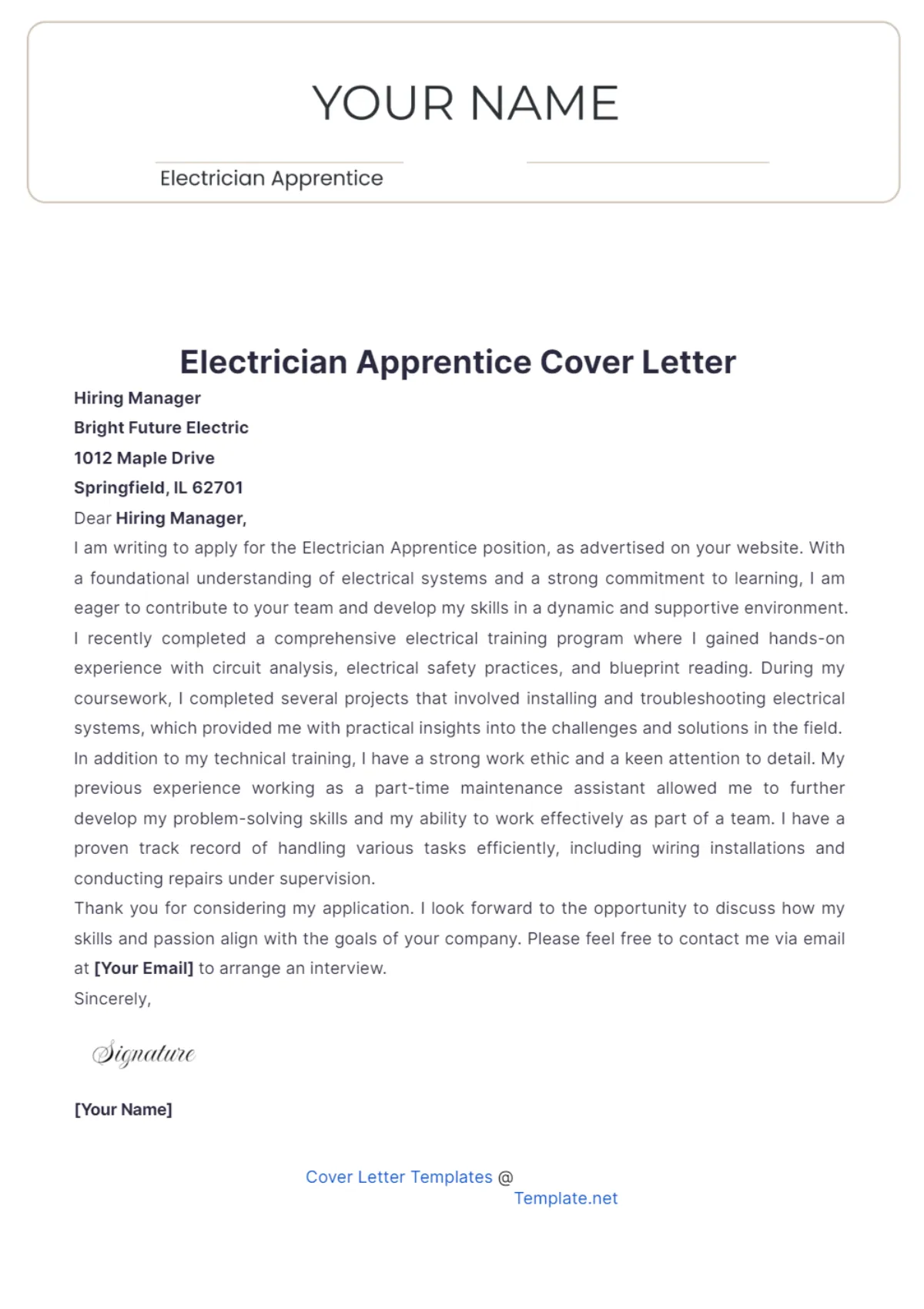
Your cover letter is where you emphasize the skills and experiences that make you a strong candidate for an electrical apprenticeship. Even if you lack direct electrical experience, focus on transferable skills. Do you have experience with tools, problem-solving, or following instructions? Highlight those. Mention any relevant coursework, volunteer work, or hobbies that demonstrate your interest in the trade. Showcase your ability to learn, your attention to detail, and your willingness to work hard. If you have any certifications, such as a high school diploma or a GED, be sure to mention them. Be specific and provide examples to back up your claims. This section of your cover letter allows you to transform your past experiences into assets. The goal is to demonstrate that you have the foundation to succeed in the demanding and rewarding field of electrical work.
Showcasing Your Enthusiasm for the Trade
Employers value candidates who are genuinely passionate about the electrical trade. Your cover letter is the perfect place to express your enthusiasm. Share why you are drawn to the profession and what aspects of electrical work excite you. Have you always been fascinated by how things work, or do you find satisfaction in solving technical problems? Include a sentence or two about what interests you most about electrical work, such as the satisfaction of building, the challenge of troubleshooting, or the opportunity to contribute to infrastructure projects. Demonstrate that you’ve researched the company or apprenticeship program and understand its values and goals. Express your eagerness to learn and your commitment to safety. A strong demonstration of enthusiasm will significantly increase your chances of standing out among other candidates. Remember, passion is contagious, and it can make a significant difference.
Structuring Your Electrical Apprenticeship Cover Letter
A well-structured cover letter is easy to read and effectively conveys your message. Follow a standard format to ensure your letter is professional and easy to understand. The structure is important because it demonstrates that you can follow direction and are a detail-oriented individual. The structure also assists with clarity and organization. It’s the road map that guides the reader through your qualifications and personal qualities. From the header to the closing, each section plays a crucial role in presenting you as a competent and enthusiastic candidate, starting with the header and finishing with your signature.
Your Header and Contact Information
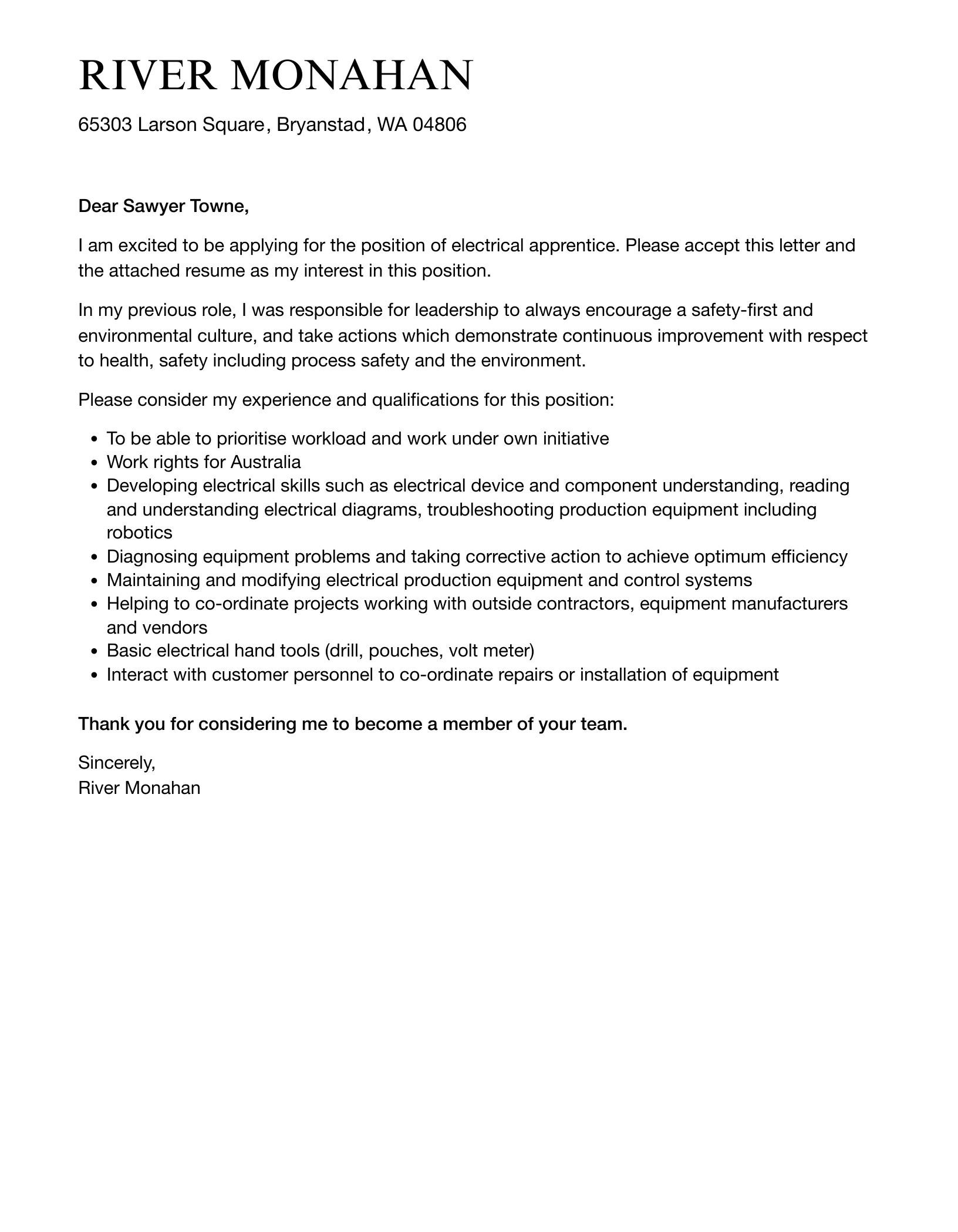
Begin your cover letter with a professional header that includes your contact information. This section should include your name, address, phone number, and email address. Make sure your email address is professional and appropriate. Include the date and the employer’s contact information, including the name of the hiring manager if known. Ensuring that all details are accurate is important because it enables the employer to reach you easily. This also portrays you as organized and meticulous, which are critical traits for an electrician. Always proofread your header to avoid any errors. Ensure the contact information is up-to-date and easily accessible for the employer.
The Salutation and Opening Paragraph
Start your cover letter with a professional salutation, such as ‘Dear Mr./Ms. [Last Name]’ if you know the hiring manager’s name. If you don’t know the name, use a general salutation such as ‘Dear Hiring Manager’. The opening paragraph should immediately grab the reader’s attention. State the position you’re applying for and where you learned about it. Briefly mention why you’re interested in the apprenticeship and what makes you a strong candidate. Expressing your enthusiasm early on is important. Your opening paragraph should be concise, clear, and compelling, setting the tone for the rest of your letter and making the reader want to learn more about you. The first sentence should make your objective crystal clear, for example, stating that you are applying for the electrical apprenticeship.
Body Paragraphs Highlighting Qualifications
The body paragraphs are the heart of your cover letter, where you highlight your qualifications and experiences. Use these paragraphs to expand on the information in your resume and demonstrate how your skills and experiences align with the requirements of the apprenticeship. Provide specific examples of your skills and accomplishments. Quantify your achievements whenever possible. Focus on your relevant skills, such as problem-solving, technical aptitude, attention to detail, and ability to work as part of a team. Relate these skills to the needs of the electrical trade. Each paragraph should focus on a specific point, supporting it with concrete examples. Remember to tailor your letter to the specific requirements and preferences of the apprenticeship program or company. This will show that you have researched the opportunity and are genuinely interested.
Closing Your Cover Letter
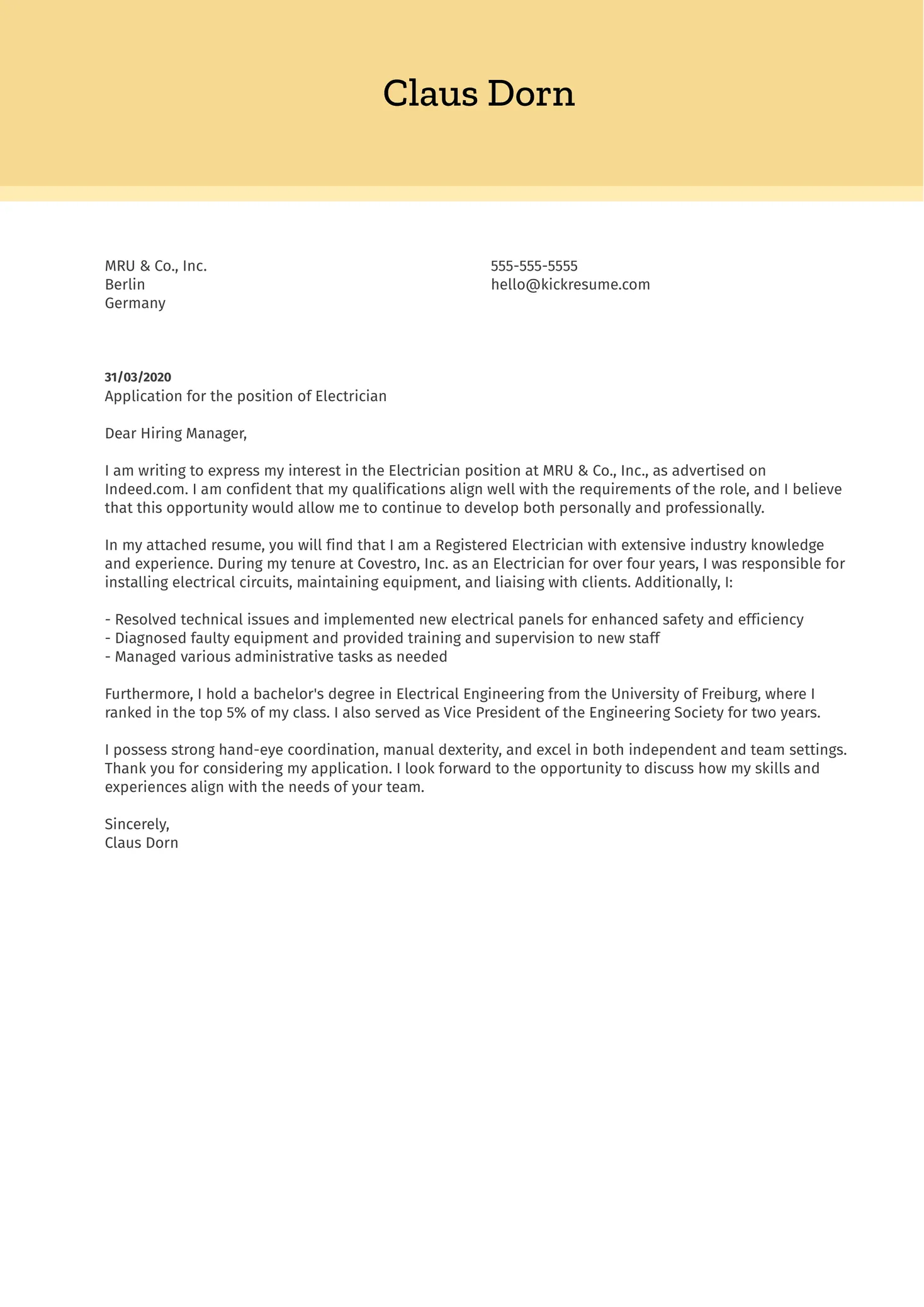
Conclude your cover letter with a strong closing paragraph. Restate your interest in the apprenticeship and reiterate your enthusiasm for the opportunity. Thank the hiring manager for their time and consideration. Include a call to action, such as stating that you are available for an interview and eager to discuss your qualifications further. Provide your contact information again for convenience. End your letter with a professional closing, such as ‘Sincerely’ or ‘Respectfully,’ followed by your typed name. Ensure your closing reflects your professionalism and eagerness to take the next step in the application process.
Proofreading and Editing Your Cover Letter
Before submitting your cover letter, take the time to carefully proofread and edit it. Errors in grammar, spelling, and punctuation can undermine your credibility and make a negative impression. Check for any typos, grammatical errors, and inconsistencies in formatting. Read your letter aloud to catch any awkward phrasing or sentences that don’t flow smoothly. Ensure your cover letter is concise, clear, and well-organized. Ask a friend, family member, or career advisor to review your letter for feedback. A fresh pair of eyes can often spot errors that you might miss. Proofreading is a crucial step in ensuring your cover letter reflects your professionalism and attention to detail.
Common Mistakes to Avoid
Avoid these common mistakes to ensure your cover letter stands out for the right reasons. Do not simply rehash your resume; use your cover letter to elaborate on your qualifications and express your personality. Avoid generic cover letters that are not tailored to the specific apprenticeship program or company. Do not use jargon or overly technical language, as this could make the letter difficult to understand. Avoid making negative statements about past employers or experiences. Do not exceed one page in length; keep your letter concise and to the point. Proofread your letter carefully to avoid any errors in grammar, spelling, or punctuation. The goal is to make a positive impression and increase your chances of securing an interview.
Seeking Feedback and Review
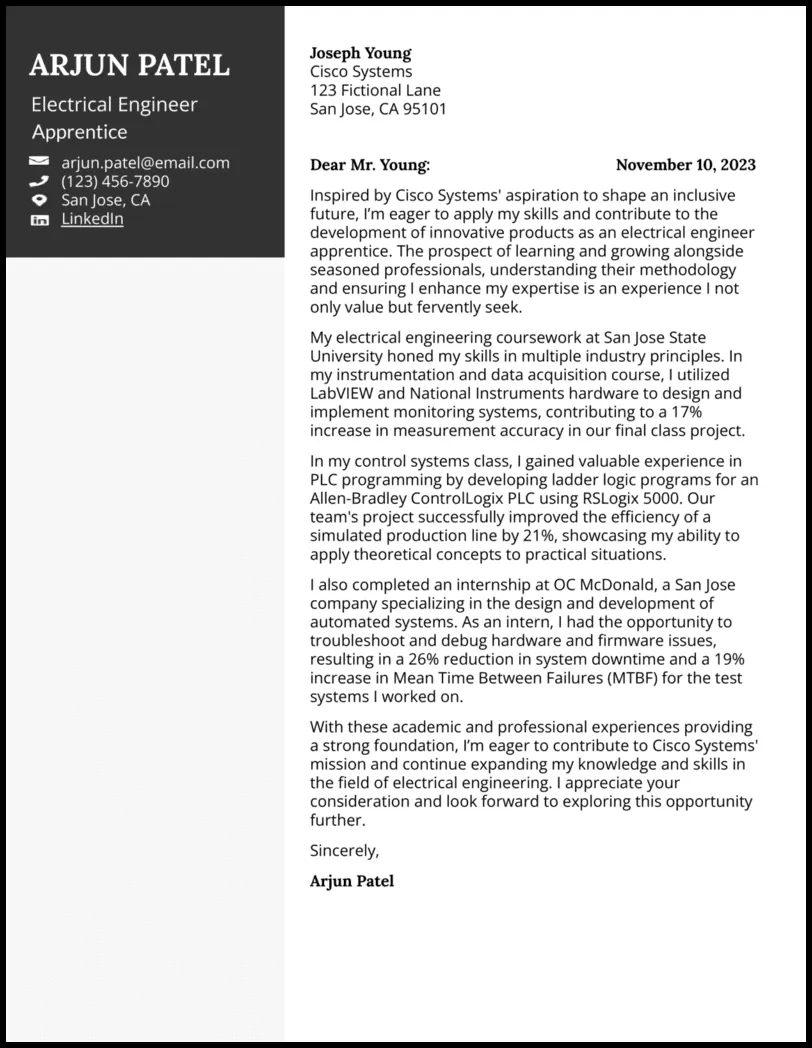
After writing your cover letter, it’s beneficial to seek feedback from others. Ask a career counselor, a teacher, or a friend or family member to review your letter. They can provide valuable insights and help you identify any areas for improvement. Ask them to check for clarity, grammar, spelling, and overall effectiveness. They can also offer suggestions for how to strengthen your letter. Consider getting feedback from someone who has experience in the electrical field. Their perspective can be especially helpful in ensuring your letter is tailored to the industry. Revise your cover letter based on the feedback you receive. Refining your cover letter will help you create a compelling and effective document that increases your chances of success.
